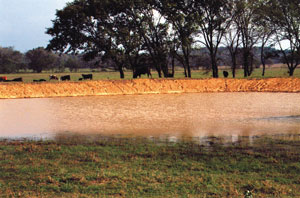Record Funding for State Conservation Cost-Share Program
The Oklahoma Conservation Commission at its Dec. 7 meeting approved guidelines for the state-funded Locally-Led Conservation Cost-Share Program for year 12. The amount allocated in the last session of the state Legislature, $948,391, is being combined with $443,809 of unobligated funds from previous years. The result is a total of $1,392,200 of program funds to be used to install natural resource conservation practices on farms and ranches.

This will be added to the $2.6 million made available by the “Conservation Bond,” passed by the Legislature for a variety of conservation projects in the state, described below. Cost-share practices funded with bond dollars must repair or restore flood-damaged conservation systems.
The Conservation Bond, passed by the Oklahoma Legislature in 2009, appropriated $25 million for conservation work to repair damage caused to the state’s conservation infrastructure by the weather events of 2007. Among projects approved for funds from the bond proceeds, along with the Cost-Share Program, is more than $15 million dedicated to repair and operation and maintenance of upstream flood control dams. A flood protection project for the Kingfisher area was also included as well as state match for a Federal Emergency Management Administration (FEMA) project. The FEMA project will repair flood control structures in south Caddo County, the area that suffered the most damage when Tropical Depression Erin devastated western Oklahoma in August 2007.
The Conservation Cost-Share Program year 12 approved Dec. 7 will extend through June 30, 2011. The board of directors at each of Oklahoma’s 87 local conservation districts selects from a state-approved list the conservation practices they feel will best address the highest priority problems affecting renewable natural resources in their area. Examples of approved practices include brush management to control invasive plant species like eastern redcedar or to improve or restore native wildlife habitat. Brush management may also be used to protect life and property from wildfire hazard. Ponds, terraces and water diversions are practices that help control soil erosion and improve water quality. In Critical Area Planting, vegetation is planted on highly erodible soil to reduce damage from sediment and runoff to downstream areas. Fencing is a practice used to exclude livestock from areas that should be protected from grazing such as tree plantings, wildlife areas or cropland.
“In a time when the economic climate of Oklahoma is starting to be compared to the time of the Great Depression, it is vital that we not let our guard down in protecting our natural resource environment,” said Mike Thralls, executive director of the Oklahoma Conservation Commission. “These conservation practices are indispensable in protecting our great state from a recurrence of the Dust Bowl, especially in years like 2006 that was drier than any during the Dust Bowl. We are especially pleased to have leveraged our resources to be able to increase our assistance to landowners in that defense during this difficult time,” Thralls said. “The Conservation Cost-Share Program also helps stimulate local economies,” Thralls said. “Each dollar spent on conservation in local areas can multiply as much as two-and-a-half time as it is spent and rolls over in the local economy.
Conservation practices must be carried out according to specifications provided by the USDA Natural Resources Conservation Service. That ensures practices such as ponds, diversions, terraces and other structural practices are constructed properly and function as designed. To date the Locally-Led Conservation Cost-Share Program has assisted 7,885 landowners since it began in 1998.
